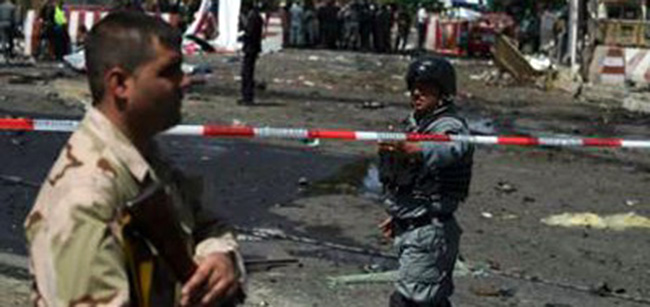In recent months, the stories told by Afghans have been sad ones that have largely to do with deaths. We have counted the death of individuals who fell victim to terrorism. The emergence of the self-styled Islamic State of Iraq and the Levant (ISIL) compounded the political instability through ushering in sectarian violence. The ethnic minority groups are seriously left at the mercy of terror. The pictures of men, women and children lying in the streams of blood spread a deep sense of fear and disappointment in the air. Not only has the shadow of the sudden deaths of innocent people inculcated a deep sense of paranoia in those who have lived, it has ripped the fragile threads of national unity, religious tolerance and general civility.
Afghanistan, along with Pakistan and Syria is, reportedly, among the top five countries most hit by terrorism. The Monday attack on a Shiite mosque, Baqir Al-Uloom, in Chahar Qala area of capital Kabul, which left at least 32 dead and more than 60 wounded behind, was claimed by the ISIL group. ISIL carried out attacks in 28 countries in 2015, up from 13 the year before. It may be only one of the world’s 274 terrorist groups, but it is the most deadly. Similarly, ISIL carried out two attacks during the Shiite ceremony of Ashura in October 11 in Kabul and in October 12 in the northern province of Balkh, that altogether killed at least 32 people. The group also claimed responsibility for the attack, took place in July 23, against a demonstration by mainly Hazara Shiites in Kabul, killing at least 85 and injuring 413, the deadliest attack in Afghanistan on civilians since 2002.
It is believed that Afghanistan has borne the brunt of terrorism within the two past years. The last year “spring offensive” and this year’s “Omari Operation” of the Taliban and ISIL’s firm foothold in the country heightened the graph of soldier and civilian casualties. Based on national media, around 3,285 people have been killed and wounded in 193 attacks across Afghanistan only last month, showing a 35 percent increase in assaults and 83 percent hike in causalities, compared to September. In September, 1,065 people were, reportedly, killed and 727 others wounded in 143 clashes and attacks in 27 provinces.
According to a report, the OECD (Organization of Economic Cooperation and Development) countries, which include mostly developed Western nations, saw a huge increase in the number of terrorist attacks. These countries, which include the United States and France amongst others, saw a 650pc increase in the number of deaths in such attacks.
Twenty-one of the 34 OECD countries saw at least one act of terror, with the most attacks taking place in Turkey and France. In 2014, there were 18 deaths from terror attacks in OECD countries. In 2015, this number had increased to 313 deaths from 67 attacks. In the US, 98pc of terror attacks were carried out by single individuals who may or may not have declared allegiance to IS but who did not have any direct contact with the organization.
Following the Monday attack, Human Rights Watch (HRW) asked the National Unity Government (NUG) to develop a security plan to better protect the minority Shiite sect during high-profile public events. “ISIS has stepped up its horrific and unlawful attacks on public gatherings, making no place safe. The government, Shia leaders and civil society groups should work together to develop appropriate ways to improve security during vulnerable public and religious gatherings so that Shia community members can exercise their basic rights,” a senior Afghanistan researcher at HRW Patricia Gossman is cited as saying.
Not only is this outlook unrelated to the sort of attacks being witnessed in most of these countries (it is said 98pc in the US are carried out by single individuals), it also makes cooperation on the collective project of fighting terrorism all but impossible.
Moreover, Afghans have to treat one another with the spirit of brotherhood regardless of one’s sect, race and creed and practice religious tolerance in the society. With the message of peace and brotherhood, one day we will be able to overcome instability and become united against our common enemy. It is worth saying that the more divided we remain the more pain and sufferings we will sustain. Stoking sectarian violence is a project being implemented by the ISIL fighters. They seek to segregate the nation on the grounds of their racial and religious background. Although Afghans maturity is appreciable, there are still grounds for being attracted towards the radical ideology of the ISIL, particularly in the tribal belts located on the Afghan-Pak borders.
Home » Opinion » The Sacrificial Lambs of Terrorism
The Sacrificial Lambs of Terrorism
| Hujjatullah Zia

